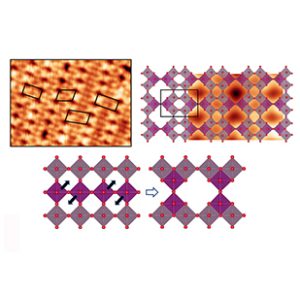A Nanoscale Twist: Discovery of 2D Magnéli Phases in MoO₃ Films
 The reduction of molybdenum trioxide (MoO₃) profoundly modifies its structural and electronic properties, making it a material of interest for numerous technological applications, ranging from (photo-)catalysis to optoelectronics, or electrochromic devices, among others. Although substoichiometric Magnéli phases are well known in bulk MoO₃, the reduction behavior and mechanisms of oxygen deficiency at the nanoscale remain poorly understood.
The reduction of molybdenum trioxide (MoO₃) profoundly modifies its structural and electronic properties, making it a material of interest for numerous technological applications, ranging from (photo-)catalysis to optoelectronics, or electrochromic devices, among others. Although substoichiometric Magnéli phases are well known in bulk MoO₃, the reduction behavior and mechanisms of oxygen deficiency at the nanoscale remain poorly understood.
In a collaborative effort with the University of Graz, Austria (STM, LEED, XPS), researchers at INSP (DFT modeling) have analyzed the surface phases arising during the reduction of palladium-supported ultrathin MoO₃ films. They discovered that the observed defect patterns correspond to ordered assemblies of a peculiar type of surface oxygen vacancy, formed when MoO₃ octahedra shift from a corner-sharing to an edge-sharing arrangement. The resulting substoichiometric shear lines represent two-dimensional analogues of the bulk Magnéli crystallographic shear planes. Their uniquely nanoscale character is confirmed by the instability of such phases on bulk MoO₃ surfaces.
Their first observation in reduced MoO₃ nanolayers indicates that similar two-dimensional Magnéli-type phases could also emerge in other reducible oxide nanostructures, where enhanced structural flexibility enables the formation of otherwise inaccessible phases.
Caption: Top: STM image showing surface defect patterns with varying periodicities (left) and a superimposed model of the two-dimensional Magnéli-type phase illustrating the ordered arrangement of a peculiar surface oxygen vacancy (right). Bottom: Schematic representation of the structural transformation of surface MoO₃ octahedra from corner-sharing to edge-sharing configurations, resulting in the formation of substoichiometric shear lines.
Reference
Two-Dimensional Defective MoO3−x Layers: Formation of a Magnéli-Type Nanophase
Jacek Goniakowski, Claudine Noguera, Falko P. Netzer, and Svetlozar Surnev
ACS Nano 2025, 19, 33913−33925
https://doi.org/10.1021/acsnano.5c09324

